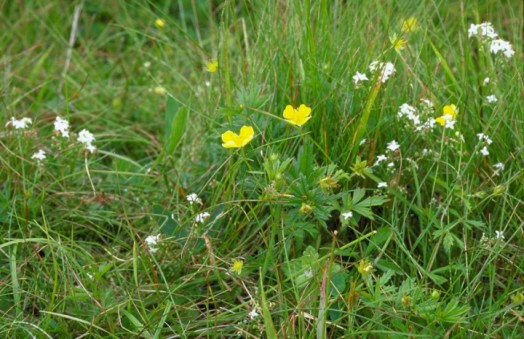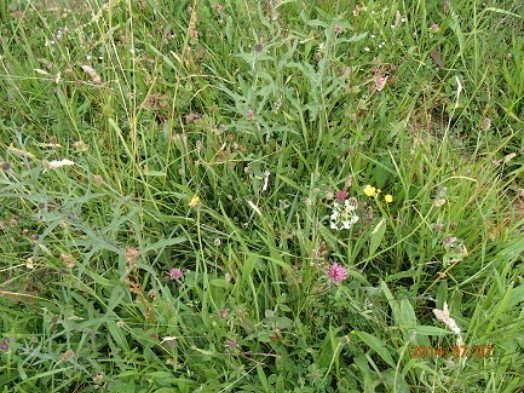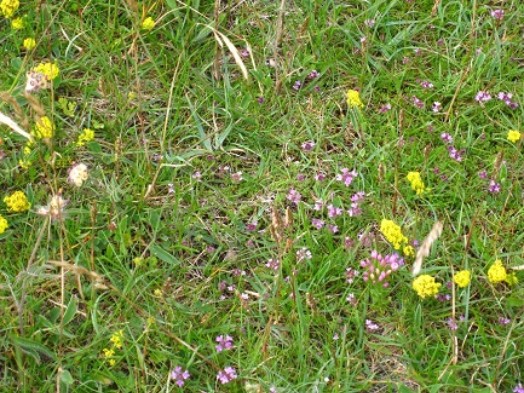Supporting guidance for Species-rich Grassland Management
This is an old version of the page
This is an old version of the page
Date published: 30 March, 2015
Date superseded: 14 December, 2015
Species-rich grasslands are valuable wildlife habitats and are found throughout Scotland. However, they have declined dramatically in recent decades and now occupy just two per cent of Scotland’s farmland grassland.
Flower-rich grasslands support a range of scarce plants as well as a wide range of other species. Insects are particularly reliant on the food and shelter that these diverse habitats provide. Many species of bumblebee depend upon the pollen and nectar in wildflower grasslands and some butterflies, such as the northern brown argus, rely on well-managed calcareous grasslands.
Types of grassland
Species-rich grasslands can be acid, neutral or calcareous and this depends largely on the soil type.

1. Acid grassland
Yellow tormentil and white-flowered heath bedstraw growing, together amongst fine-leaved bent and fescue grasses, are good indicators of acid grasslands. There is never a great variety of wildflowers in acid grasslands, but there may be harebell, devil’s bit scabious, dog-violet, bitter vetch or the small red flowers of sheep’s sorrel.
There may also be heather and blaeberry and there is often a layer of moss.
Productivity is generally low.

2. Neutral grassland
A wide variety of flowers are typical of neutral grassland. They include the common knapweed, bird’s-foot trefoil, meadow vetchling, lady’s bedstraw, meadow buttercup, yellow rattle, yarrow and selfheal, as well as the less colourful ribwort plantain and common sorrel.
Neutral grasslands are easily converted to productive but species-poor meadow or pasture.
Few have survived the agricultural improvements of the last half-century, except for the western Highlands and Islands where many are maintained by traditional management for hay or pasture.

3. Calcareous grassland
Calcareous grassland is usually found in small scattered patches on shallow soils, on steep slopes or by rock outcrops and follows the distribution of calcareous rocks and soils in the landscape.
The purple flowers of thyme are the best indicator of calcareous grasslands since it is almost always present, growing amongst fine-leaved bent and fescue grasses. This type of grassland is usually herb-rich, with a variety of small plants such as rockrose, eyebrights, milkwort and fairy flax, as well as the distinctive quaking grass, with flowers that tremble in the wind.
What does species-rich grassland look like?

Different species of wildlife need different amounts of light, shade and shelter, as well as different sources of food, so the best grassland for wildlife contains a variety of conditions to suit a variety of plants and animals.
Ideally there will be some short open areas where new seedlings can grow and some dense tussocks to shelter invertebrates and small mammals, with a range of heights between. Plenty of flowers should be visible in summer with bees, moths and butterflies feeding from the flowers on sunny days.
The sward height will be mostly between:
- 3 and 20 centimetres if it is acid grassland
- 5 and 20 centimetres if it is neutral grassland
- 2 and 15 centimetres if it is calcareous grassland
You can measure sward height by placing a hand on the grassland to feel the level that most of the grass leaves reach, ignoring the flowers of grasses and herbs.
The sward should be at its longest in summer, while plants are flowering and setting seed. Most grassland species germinate in the autumn or spring so the sward needs to be shorter at these times, so that there is light and space at ground level for new growth.
What needs to be done?
Species-rich grassland needs to be grazed or cut otherwise the grasses will grow tall and dense and shade out the smaller plants. The traditional management of the grassland – whether it was grazed or cut in the past – is a good guide to the best management for the wildlife living there now.
Grazing is usually the preferred management since grazing animals create variety by eating, dunging and trampling unevenly across the field.
Cattle tend to be better suited to taller grasslands and, since they are less selective grazers than sheep, light summer grazing with cattle can still allow flowering and seed set.
Sheep may be better suited to grazing shorter grasslands, particularly on fragile sites vulnerable to poaching. Since they selectively eat flowers, a four to eight week exclusion period in the summer may be a good idea when you are grazing with sheep.
Where there are no livestock you can manage species-rich grassland by cutting late in the summer, no earlier than 15 July. Grass cuttings should be baled and removed or they will smother the sward and add to the fertility of the soil, leading to a decline in species-richness.
Grassland managed by cutting alone can be very uniform so it is a good idea to leave five to ten per cent uncut each year, a different area each time, to vary the sward height and allow seed to set seed. Grazing after cutting (aftermath grazing) will also create variety.
Restoring and creating species-rich grassland
You can restore species-rich grassland from species-poor, semi natural grassland by part-cultivating then over-sowing with wildflower seed. And you can create species-rich grassland from arable rotation or grass ley by cultivating, creating a stale seedbed and sowing with wildflower seed. A good wildflower mixture includes plenty of legumes to support bumblebees.
Once the diversified sward has been established, it will need to be managed as for species-rich grassland.
Management of scrub, weeds and bracken
Small amounts of scrub in species-rich grasslands add to the habitat diversity and benefit insects and birds. Appropriate grazing management should help prevent excessive scrub colonisation but additional manual control may be needed on some sites.
Scrub control is funded as separate capital items:
- Control of Scrub or Woody Vegetation – Primary Treatment – Light Vegetation
- Control of Scrub or Woody Vegetation – Primary Treatment – Intermediate and Heavy Vegetation
- Control of Scrub – Follow-up Treatment
- Control of Scrub or Woody Vegetation – Removal from Site of Cut Vegetation
Weed species such as docks and creeping thistle should be controlled where they significantly reduce the area of species-rich grassland. Weeds can be chemically spot-treated provided you have prior written agreement from your case officer.
The spread of bracken gradually smothers ground vegetation, resulting in the loss of species-rich grassland. Ideally, you should control bracken before the understory of wildflowers and grasses has been lost. If the ground vegetation has been completely replaced with dense bracken litter, we recommend you take advice about how to encourage it to regenerate.
Open bracken can provide good habitat for ground-nesting birds and reptiles such as adders. Bracken on south-facing slopes is an important element of pearl bordered fritillary butterfly habitat and care should be taken when controlling bracken where this species is present.
Bracken control can be undertaken as part of your plan and separate funding is available for this:
Further information
- Grassland management guide (SNH)
- Grasslands booklet (SNH)
- Guide to conservation grazing (SAC)
- Land management for butterflies (SAC)
- Grassland Gems: Managing Lawns and Pastures for Fungi (Plantlife)
- Management of grasslands for insects (Buglife)
- Reptile Management Handbook (Amphibian and Reptile Conservation)
- Amphibian Management Handbook (Amphibian and Reptile Conservation)
